Why a Create a Bamboo Farm?
I Moved from Washington State to Perry, Georgia, on October 15, 2010. I had no intention of buying land and planting a bamboo research farm. My plan was to work with twenty-year old mature groves located in Fort Valley and Bonaire, owned and planted by Robby Russell. The data that I got from these groves from 2011 to 2013 was discouragingly less than the data that I expected. In Seattle from two henon groves that I worked with, I got 2500 pounds per acre from one and 5600 pounds per acre from the other. In Bonaire, my henon produced an average of 667 pounds per acre. In Fort Valley, it produced an average of 567 pounds.
Yields of the other seven varieties were lower than I expected also. I had to get better numbers in order to promote bamboo as a farm crop. I had to grow bamboo where I can irrigate and mulch and fertilize.
In 2013 I bought 12 acres of rural land in Hawkinsville, Georgia. I cleared three acres for planting bamboo and left the other acres alone. In April, 2014, Robby Russell’s crew installed irrigation, planted twelve varieties of bamboo, and mulched with round-bales of hay. In October, my new house was delivered by truck and I moved in. I was 73 years old and living my dream.
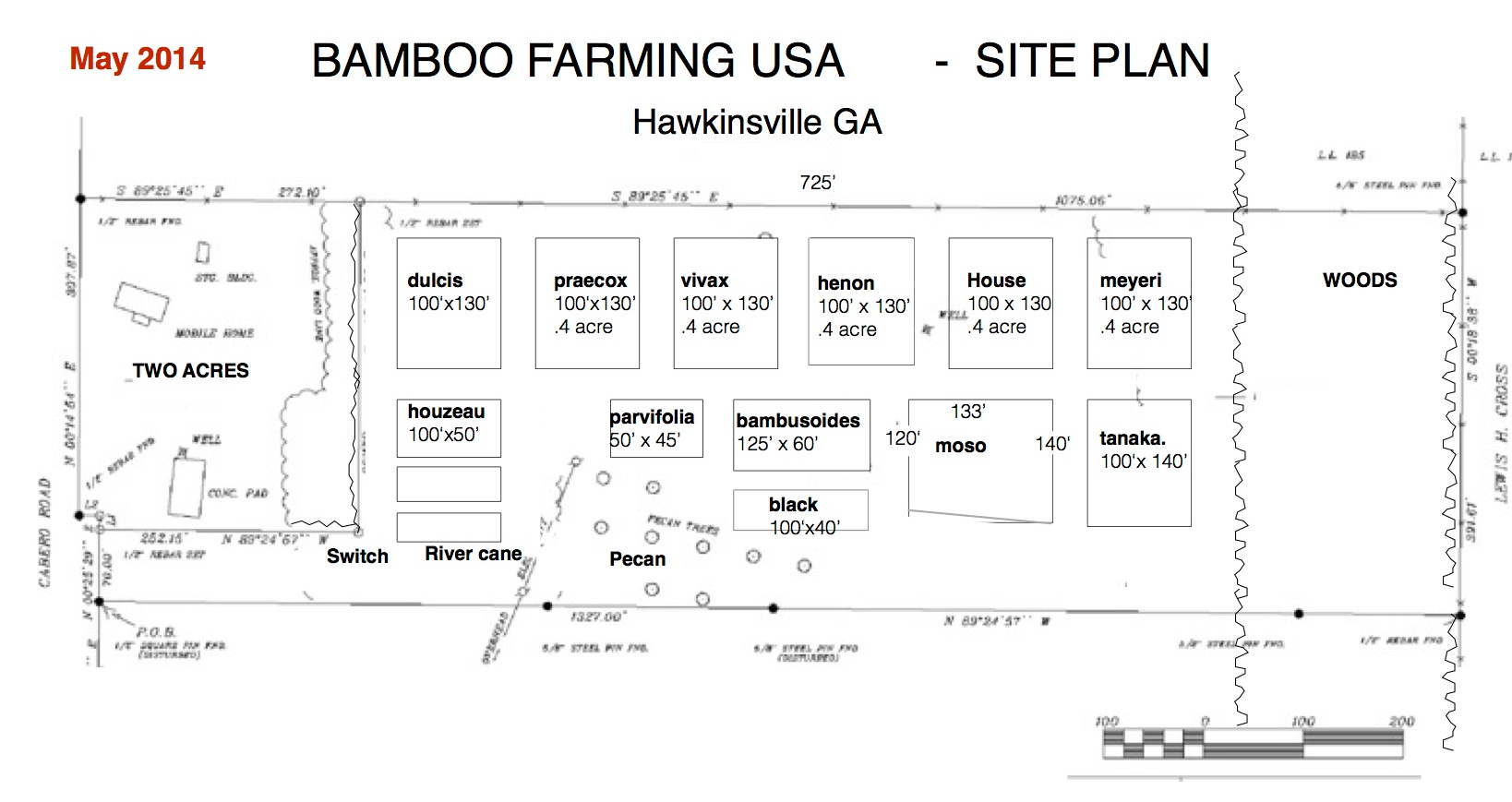
What varieties did I plant?
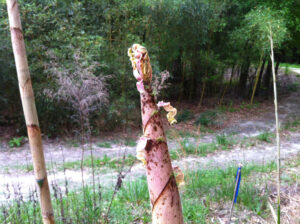 Phylostachys Dulcis because it is called both Sweet Shoot Bamboo and Vegetable Bamboo. Frank Meyer introduced Dulcis in 1908 from Zhejiang Province, China. He described it as “the edible bamboo grown in nearly every backyard in Central China”. Grove is lovely to walk in.
Phylostachys Dulcis because it is called both Sweet Shoot Bamboo and Vegetable Bamboo. Frank Meyer introduced Dulcis in 1908 from Zhejiang Province, China. He described it as “the edible bamboo grown in nearly every backyard in Central China”. Grove is lovely to walk in.
Can grow to 40 feet tall. Can have three inch plus diameter canes at thirty feet high. Good for a suburban planting because it feels like a large bamboo even though its height is shorter. Shoots are tender; poles are weak and not especially straight.
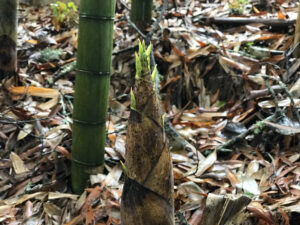 Praecox because it is the earliest to shoot and because it produces well in Fort Valley. Its poles are straight and uniform. I have allowed it to spread south from Plot 1 to create Plot 2.
Praecox because it is the earliest to shoot and because it produces well in Fort Valley. Its poles are straight and uniform. I have allowed it to spread south from Plot 1 to create Plot 2.
I made mugs from a praecox pole. The skin when cured has a coat of dark specks over the normal blonde color of bamboo poles. Quite ornamental and the poles are strong.
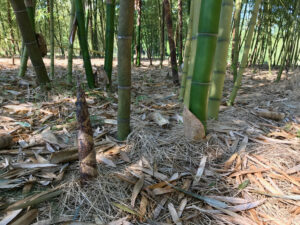
Vivax because it is big and matures fast. Shoots are lovely, hairless, and free of acridity. Now, in 2019, just five years old, my Vivax is the most striking of my bamboos – big canes, open habit, big, deep-green leaves. People enjoy walking through this grove more than any other on my farm.
I was told by Noah Bell of Bamboo Gardens that tea made of vivax leaves is stronger flavored than other bamboo teas. When I look at my various groves, the Vivax grove is a darker green than any of the others.
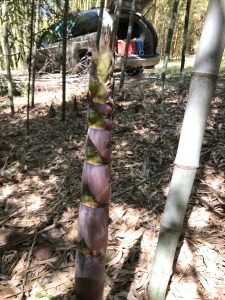 Henon because I worked with it in Kirkland, Washington, and knew it to be good for shoots and for poles and to be drought resistant. In year 2019 my henon is less vigorous, less attractive than the other eleven species all planted in 2014. Like Ph. nigra, the canes droop over in rain. I don’t expect so much leaning and drooping when the grove is mature. In the years to come, I will be glad that I planted henon, the Giant Grey Bamboo.
Henon because I worked with it in Kirkland, Washington, and knew it to be good for shoots and for poles and to be drought resistant. In year 2019 my henon is less vigorous, less attractive than the other eleven species all planted in 2014. Like Ph. nigra, the canes droop over in rain. I don’t expect so much leaning and drooping when the grove is mature. In the years to come, I will be glad that I planted henon, the Giant Grey Bamboo.
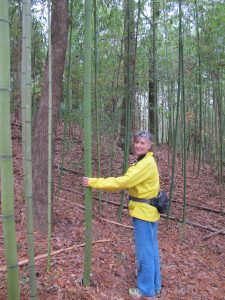 Meyeri because in Bonaire across the wetlands from Robby Russell’s bambusetum, there is a wooded hillside. Among the trees is an acre or so of Meyeri. I am astonished by this grove. As best as I know, no one has thinned or cared for this grove. There are no dead poles littering the grove. The canes are uniformly two inch diameter and straight. The branches are far up the culm. You can walk among the canes easily.
Meyeri because in Bonaire across the wetlands from Robby Russell’s bambusetum, there is a wooded hillside. Among the trees is an acre or so of Meyeri. I am astonished by this grove. As best as I know, no one has thinned or cared for this grove. There are no dead poles littering the grove. The canes are uniformly two inch diameter and straight. The branches are far up the culm. You can walk among the canes easily.
Named for Frank Meyer, the USDA plant collector/explorer who introduced it in 1907 or 1908. Richard Haubrich writes “the culms are among the finest and strongest of the genus”.
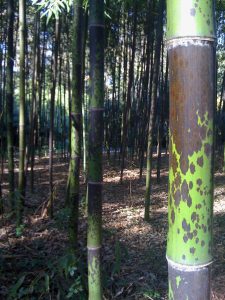
Tanakae because Robby Russell has a grove of Tanakae in Fort Valley. It is a colorful variety of Japanese Timber. Its full name is Phyllostachys bambusoides ‘Tanakae’. Japanese Timber is a premium bamboo for crafts. Japanese Timber ‘Tanakae’ has canes that are beautifully marked. I plan to sell its poles at a premium.
Bambusoides’ shoots come at the end of the shooting season. They extend the season for selling shoots.
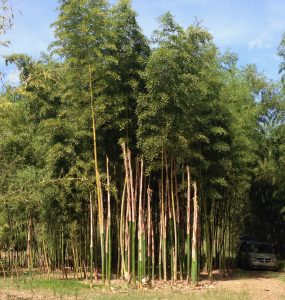 Houzeau because it has been a consistent shoot producer in Bonaire – until it got diseased in 2015. It fills the late April early May time slot for shoots. I like the smooth, hairless, fat shoots.
Houzeau because it has been a consistent shoot producer in Bonaire – until it got diseased in 2015. It fills the late April early May time slot for shoots. I like the smooth, hairless, fat shoots.
Houzeau spreads more aggressively than its Bonaire neighbors which are black, henon, moso, Allgold. Now that I have buyers for my shoots, I harvest Houzeau shoots in these neighboring groves so the vigorous spreading is an asset.
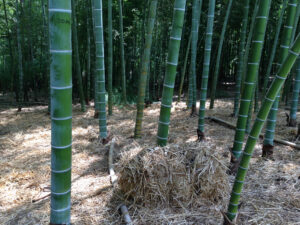 Moso because it is the biggest Phyllostachys. It creates more buzz than any other temperate bamboo. I will be experimenting to see if I can reduce the severe, alternate-year pattern of yield. My plants are seedlings grown by Robby Russell. Each seedling is different. In other words, my grove is not a collection of clones. As the individuals spread and grow together in a mature grove, yearly thinning of the smaller canes will rogue out seedlings with genetics for small size.
Moso because it is the biggest Phyllostachys. It creates more buzz than any other temperate bamboo. I will be experimenting to see if I can reduce the severe, alternate-year pattern of yield. My plants are seedlings grown by Robby Russell. Each seedling is different. In other words, my grove is not a collection of clones. As the individuals spread and grow together in a mature grove, yearly thinning of the smaller canes will rogue out seedlings with genetics for small size.
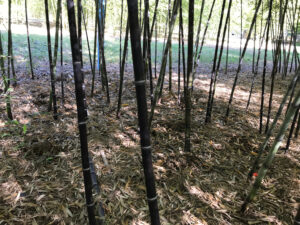 Black because everyone loves black bamboo. When we torch the black canes, the oil comes out and the pole is stunning.
Black because everyone loves black bamboo. When we torch the black canes, the oil comes out and the pole is stunning.
Black is notorious for drooping out from the grove. I hope when it is mature that it will be more erect along the edges.
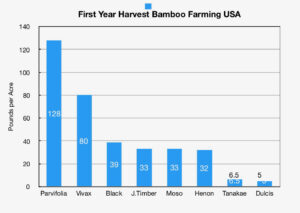
Parvifolia because it is called the Moso of the North. Will it also do well in the South? I planted parvifolia in September 2014 from rhizomes with small canes mail-ordered in a box. The graph shows that in 2019, the parvifolia provided more shoots than the vivax! And it is growing in a smaller area and was planted 5 months later. It is sizing up quickly. It is a nuisance to throw onto the trailer because its branches are fairly perpendicular to the culm and are stiff. They won’t lie down and pack easily.
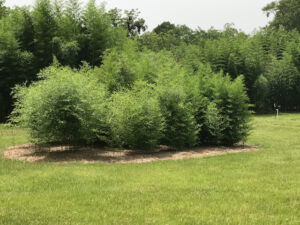 Phyllostachys irridescens planted in 2017 from a single pot. In that pot was a piece of Golden bamboo. I am letting the two coexist on the same plot. This photo shows growth three years from a single pot. I add thick mulch around the perimeter to encourage the spread. The golden is the darker denser small section to the right in the planting.
Phyllostachys irridescens planted in 2017 from a single pot. In that pot was a piece of Golden bamboo. I am letting the two coexist on the same plot. This photo shows growth three years from a single pot. I add thick mulch around the perimeter to encourage the spread. The golden is the darker denser small section to the right in the planting.
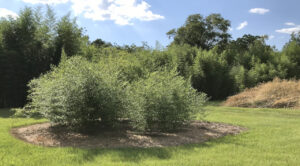
The next photo shows Phyllostachys irridescens after I cut out the golden bamboo in July 2020. I changed my mind about allowing two varieties in the same grove. The grove is more open without the golden bamboo.
Golden bamboo is an excellent hedge plant because it maintains lower branches and is dense in habit.
Notice the pile of bamboo poles (with branches and leaves) to the right of the Ph. irridescens photo. Even though my groves are young, they produce A LOT of poles to be thinned. We will have to rent a chipper within the next month.
Phyllostachys atrovaginata planted in 2020 from a single pot with one cane. I wanted this bamboo because it is tolerant of saturated soil. No photo yet.
River Cane because it is one of three bamboos native to the United States. It was important to native Americans. They used it for construction of houses, blow guns for shooting birds, weaving baskets and panels, and habitat for game and livestock. I look forward to growing and displaying a historic plant. Arundinaria gigantea
Switch Cane because it is native to the United States. I see it when I drive near creeks. It grows mixed with other roadside vegetation. Mine is not near a creek and suffers from dry soil. Arundinaria tecta
Pseudosasa amabilis because it is a different genus and I am curious. It is used for making fly rods. The mature grove at Robby Russell’s is majestic. I will see if the shoots are edible. In Year Four from planting, the diameter of the canes is too small to consider harvesting shoots. Tonkin Cane. I like this bamboo for feeding my steers. The branches are short so after the steers eat the leaves, the canes are easy to pile.
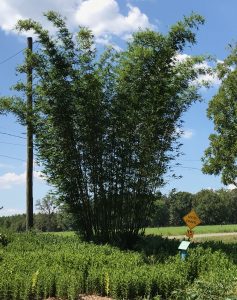
Other Bamboos: I have three tropical bamboos and eight dwarf bamboos also planted at the farm. All are beautiful. The bambusas are a tropical genus.
Bambusa textilis – Weaver’s Bamboo – Lost all its leaves in December 2022 after two nights at 19°F
Bambusa ventricosa Clone X – Its long side branches made for mess. I cut it down. It froze December 2022. It tried to come back. RoundUp dissuaded it.
Bambusa ventricosa Kimmei – Also froze to ground. In May 2023 Two tiny shoots are poking up.
I also have dwarf bamboos, beautiful ground covers with potential for grazing. Shibatea kumasaca (surrounding the Weaver’s Bamboo in photo), Sasa palmata, Sasa veitchii, Shibatea lancifolia, Indocallamus tessellatus, Pleioblastus viridistratus, Pleioblastus distichus ‘Mini‘, plus two variegated Pleioblastus whose names I do not know.